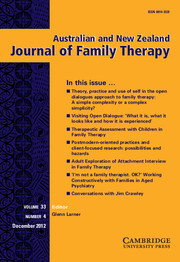Article contents
Complex Couples: Multi-Theoretical Couples Counselling with Traumatised Adults Who have a History of Child Sexual Abuse
Published online by Cambridge University Press: 06 November 2012
Abstract
One of the major ways child sexual abuse can have an impact on individuals is in their later ability to have and maintain fulfilling couple relationships. Survivors may experience avoidance behaviours that become problematic in their adult intimate relationships. If couple therapists fail to focus on these traumatic imprints, the therapy may founder. This paper proposes that a multi-theoretical approach enables the couple therapist to deal with the complex problems such couples present including sexuality and intimacy concerns. Such an approach integrates trauma theory, attachment theory, feminist principles, body-oriented psychotherapy, and systemic couple therapy.
- Type
- Articles
- Information
- Australian and New Zealand Journal of Family Therapy , Volume 33 , Issue 3: Trauma and Systemic Therapy , September 2012 , pp. 219 - 231
- Copyright
- Copyright © The Authors 2012
References
- 3
- Cited by




